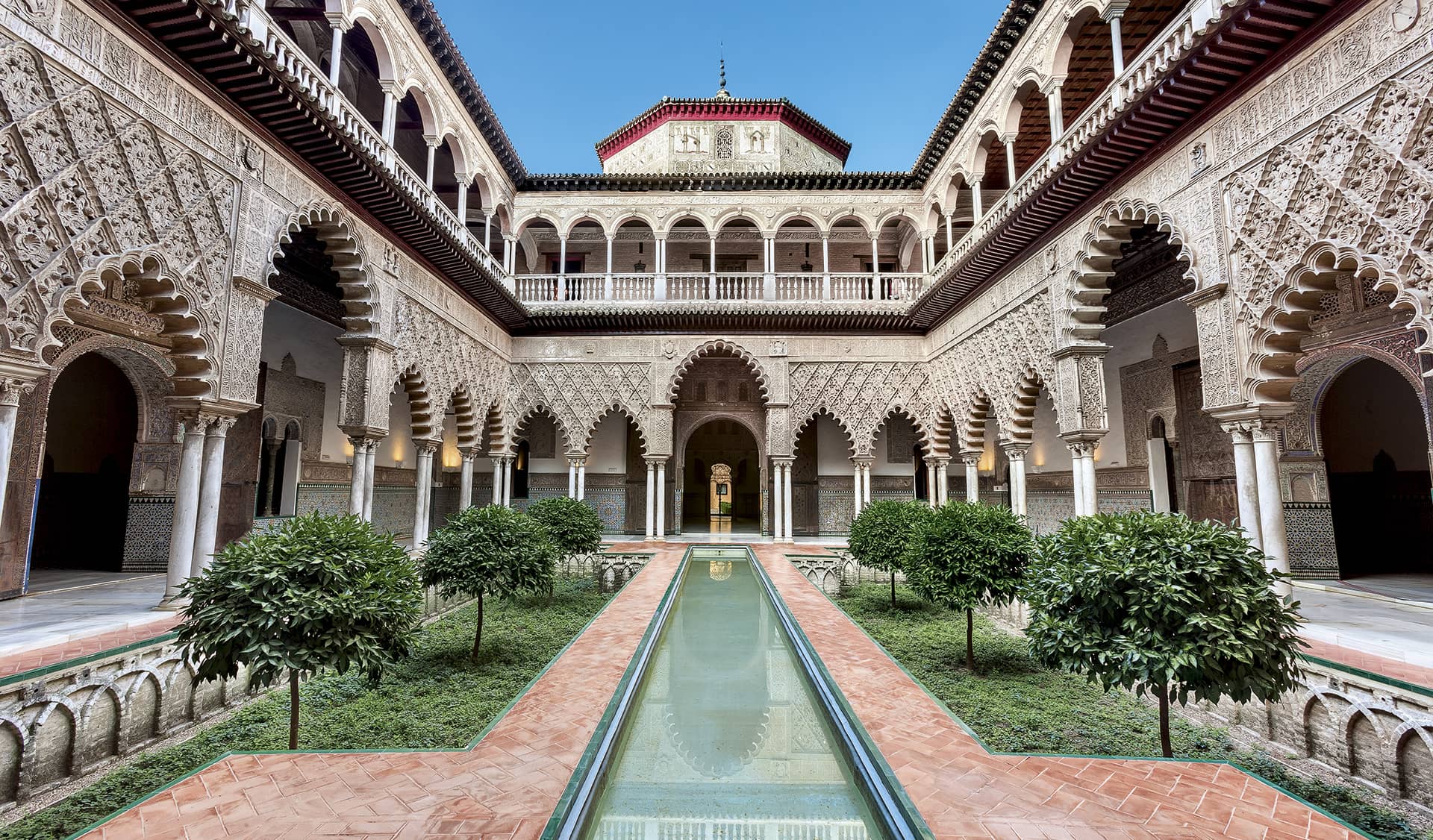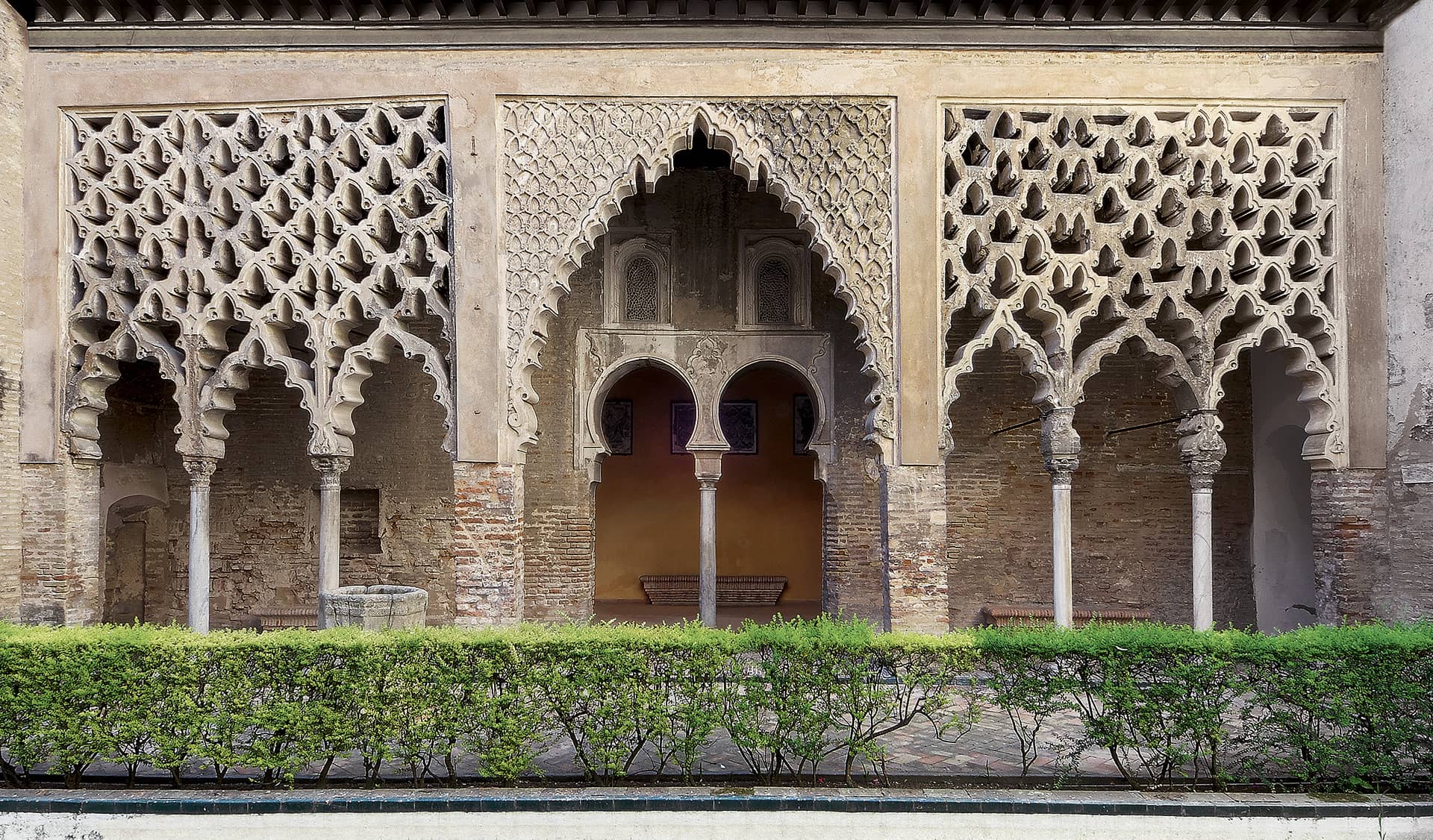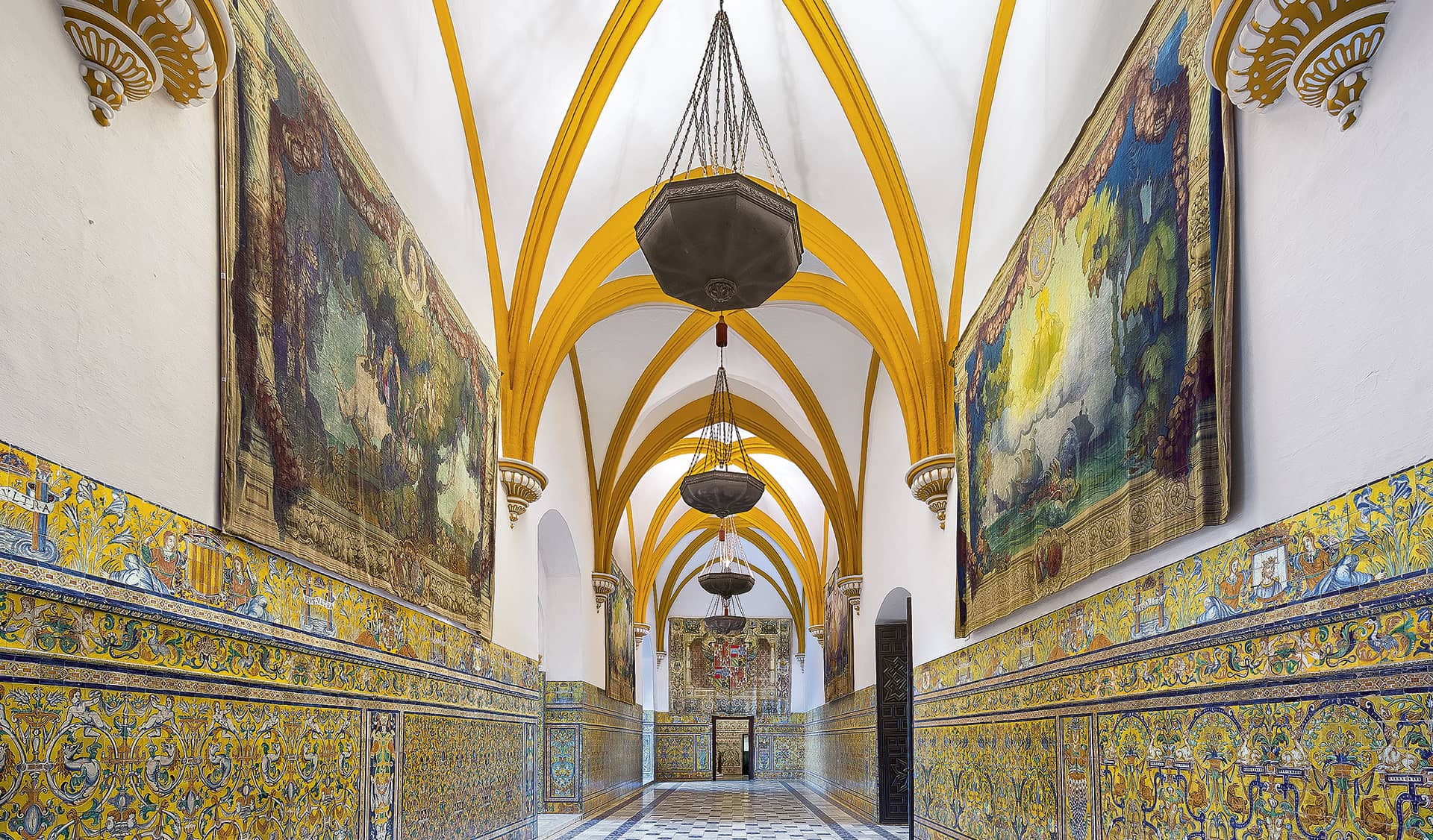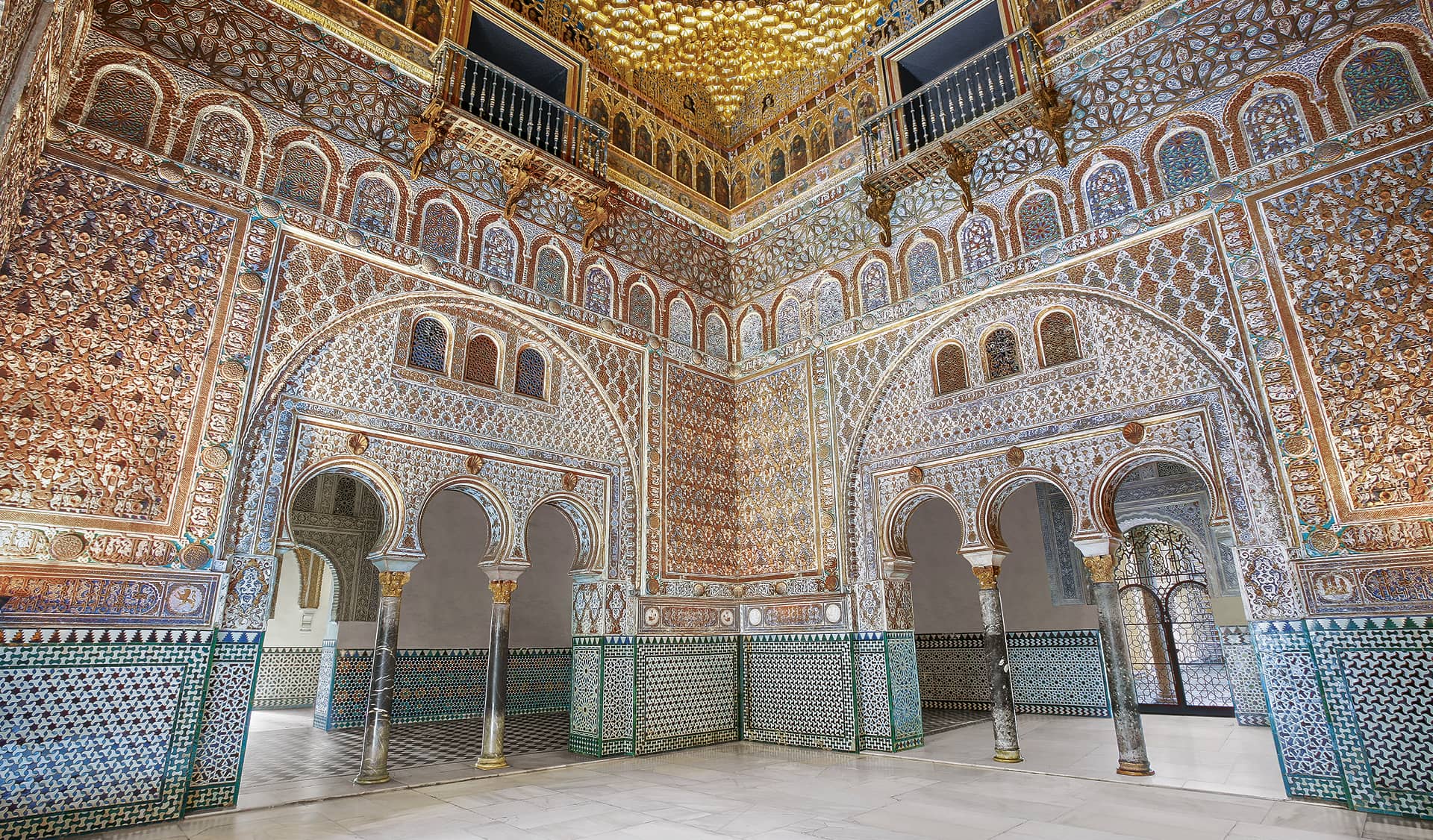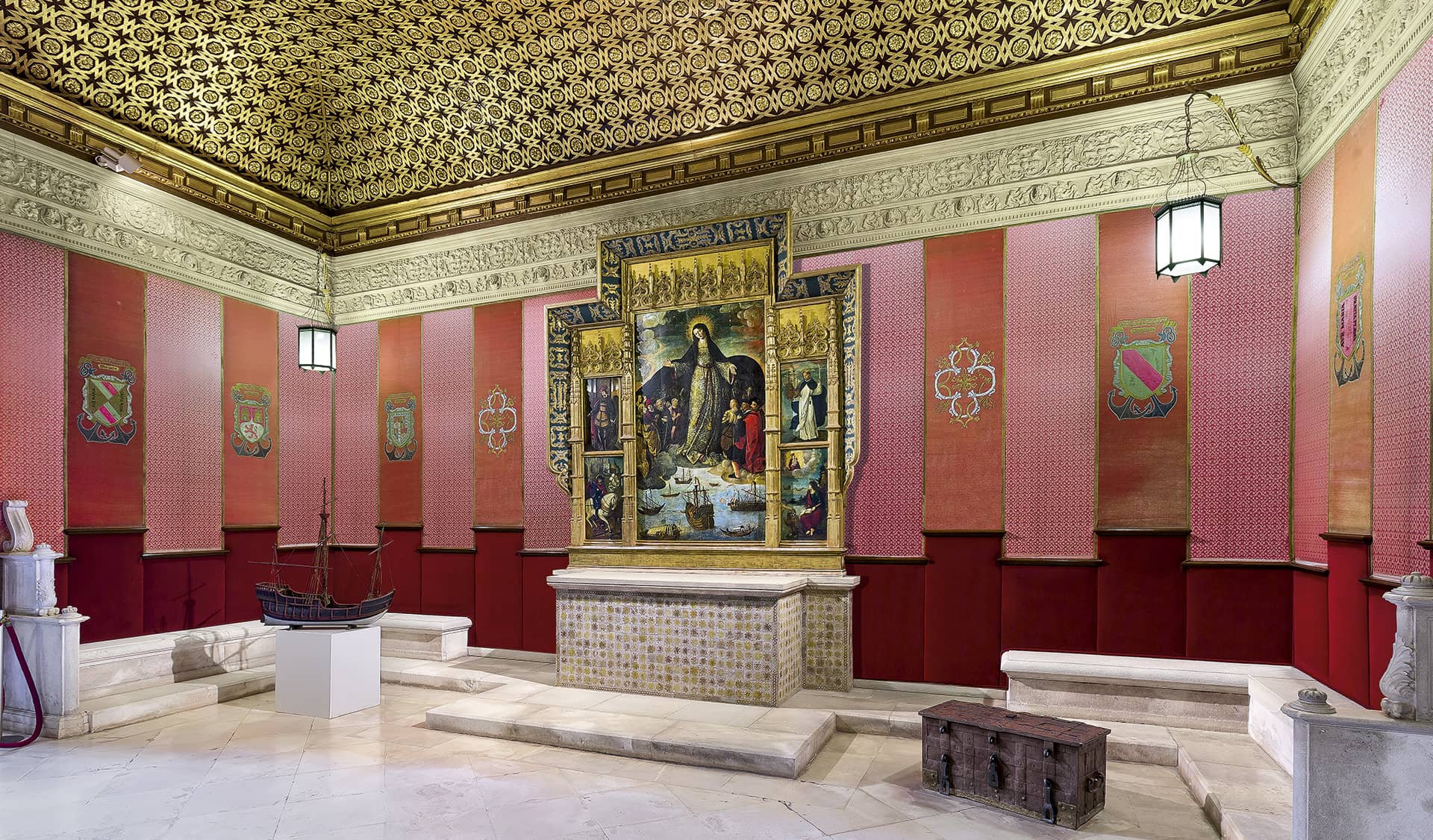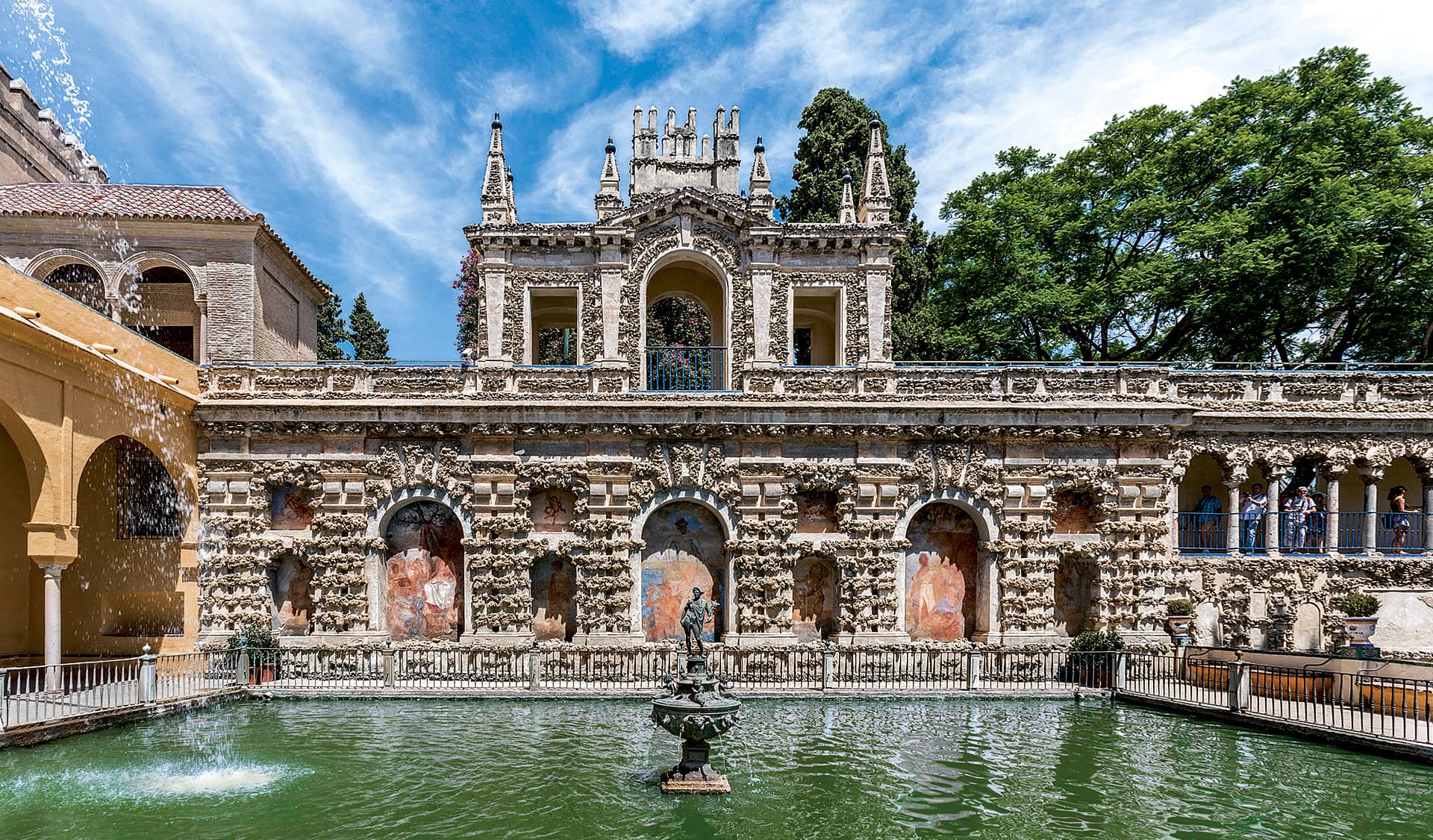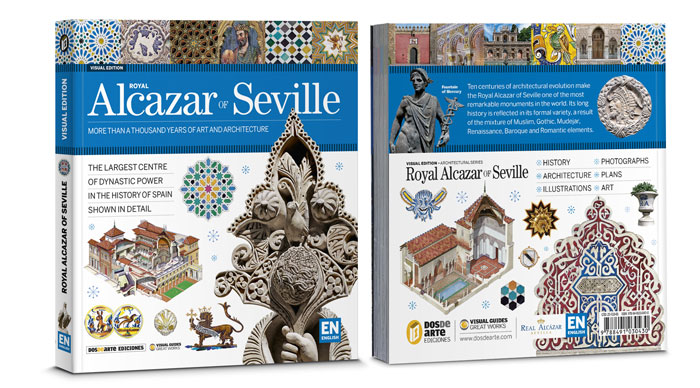What is the Royal Alcazar of Seville?
Declared a World Heritage Site by Unesco, the Royal Alcazar of Seville is Europe’s oldest palace in use. Its origins go back to the 11th century, when Muslim authorities decided to build a fortress in a strategic area of Seville in order to guarantee its security. Protected by a wall, the Alcazar site is made up of diverse palaces and gardens designed during different historical periods.
This way, the Alcazar of Seville offers a wide range of styles, combining elements typical of Muslim, Gothic, Renaissance, Baroque and Romantic art, as well as some of the best examples of Mudejar art, product of the mix of Islamic and Christian culture.
The history of the Alcazar of Seville
Since the city was founded, Seville’s evolution has been closely linked to the River Guadalquivir. Its political and demographic supremacy in many periods of history was largely due to it being on the last navigable point of the river for ships of a certain draft.
Thus, the Iberians’ Seville, called Ispal, which was home to the flourishing civilization of Tartessos around 700 BC, became the Hispalis of the Romans in 200 BC (two great Emperors, Trajan and Hadrian, were born in nearby Itálica) and it was later named Isbiliya by the Muslims following the Arab invasion of the Iberian Peninsula in 711 AD.
In the 11th century, the city’s fate was forever tied to the Alcazar of Seville, a fortress designed to protect the plaza on the banks of the Guadalquivir and to accommodate the Muslim king’s residence and the offices of the state administration.
From then on, Seville and its Royal Alcazar evolved in unison, sensitive to the intervention of each one of the monarchs who ruled within its walls and who in the majority of cases greatly admired what their predecessors had constructed. It is thanks to this admiration that the Royal Alcazar of Seville has been so well preserved, which encompasses vestiges from all ages from the Caliphate of Cordova to this day, and whose walls have witnessed great events in the history of Spain. Numerous books on architecture have studied its rich, ornate structure.
What to see in the Alcazar of Seville
The presence of the Muslims on the Iberian Peninsula lasted eight centuries, a long enough period to encompass many different trends within the Islamic world. The Emirs and Caliphs of Cordova (from the eighth to tenth century) and the Taifa kings of Seville (eleventh century), native of the Arabíga Peninsula, were followed by the Berbers in the twelfth century, who came from Morocco.
A Berber caste, the Almohads, created a great empire to the north and south of Gibraltar in order to recuperate the essence of Islam. Seville became the capital of the European part of the empire and maintained close relations with Marrakech, the headquarters of Almohad power. After settling in the Royal Alcazar of Seville, the Almohads razed the buildings of their predecessors and created a network of independent palaces to house the privileged classes.
One of these new residences was the complex that in the Christian era was named the Stucco Palace, comprised of a central courtyard and two opposite galleries, of which the one conserved is the south-east one. The site probably included elongated bedchambers along with a qubba, a square-shaped area typical of Muslim architecture that in the fourteenth century was reconstructed to become the Hall of Justice.
The Gothic Palace and the Crossing Courtyard
Ferdinand III, the King of Castile who conquered Seville in 1248, was unable to enjoy the Alcazar for very long as he was to die there just four years later. Alfonso X the Wise, his son and successor, shared his father’s admiration for Islamic art and his predilection for Seville but the palace the Almohad Caliphs had once inhabited wasn’t wholly suitable for the Castilian King’s way of life nor for the requirements of his court.
In contrast to Muslim taste for more reduced spaces of moderate height, with maze-like layouts designed for greater privacy, Christian monarchs’ tastes differed somewhat as they preferred loftier and more spacious rooms, and opted for a clear hierarchy in the different areas of the palace. Therefore, for this reason and for the prestige that Gothic art, imported from France a few decades earlier, had acquired in the Peninsula, Alfonso X chose this style to build his own palace inside the Alcazar of Seville.
Gothic forms, moreover, were strongly associated with Christianity and the Crusades, and the King’s choice for this genre symbolised the Christian Western world’s victory over Islam. Thus, the King of Castile invited masons who had worked on the naves of Burgos Cathedral, a Gothic milestone in peninsular architecture, to construct his new royal residence alongside the vestiges of the old Almohad palace.
The Palace of King Peter I
In the second half of the 14th century, Peter I, the King of Castile, not only admired Islamic culture and surrounded himself with Muslim advisors and Jews, but even signed a pact of mutual assistance with the Nasrid Sultan of Granada (in theory his enemy) so that he could defend himself better against domestic foes. Thanks to this liberal attitude and cultural and religious tolerance the Alcazar of Seville’s walls now boast the spectacular Palace of King Peter I.
The Castilian monarch greatly appreciated the Muslim’s architectural heritage and summoned artists and artisans of Arab and Berber origin from Toledo, Granada and Seville itself to build a new palace between 1364 and 1366 according to the canons of Moorish art, a more genuinely Spanish style, a combination of cultures that coexisted on the Peninsula for eight centuries despite facing eachother on the battlefield. It was this interplay that resulted in epigraphs on the palace walls such as “Glory to our Lord the Sultan Peter!”, and “May Allah protect Him!”, a clear example of this cultural fusion.
After its construction, the palace converted into the regular residence for the Kings of Castile and later on was used by the Kings of Spain, and undoubtedly became the most magnificent example of the one thousand-year-old architecture of Seville’s Alcazar.
The House of Trade
Parallel to the construction, between the years 1364 and 1366, of the Palace of King Peter I, a vast area within the walls of the Alcazar was renovated which had been previously taken up by part of the former residence of the Taifa rulers of Seville, built three centuries earlier.
This space soon became the meeting point for the nobility that participated in hunts organised by the Spanish kings, and for this reason is known as the Hunting Courtyard (Patio de la Montería). In the early sixteenth century, with the founding of the House of Trade for the Americas (La Casa de Contratación de Indias) by the Catholic Kings, the courtyard soon became the Alcazar of Seville’s real centre of gravity. The House of Trade, which in the year 1504 took up the southern side of the Hunting Courtyard, was created in order to control trade with the Americas, whose colonisation had started just eleven years prior.
Thus, these installations within the Royal Alcazar were transformed, over a period of two centuries, into the logistics centre of the first global empire in the history of mankind, an immense task that included the control and the monopoly of American goods coming into the Sevillian port, the drafting of new laws that regulated such trade, the training of navigators who would be able to guide the sailing vessels through the oceans as well as the formation of cartographers.
The gardens of the Royal Alcazar of Seville
During the period of Muslim rule, the Royal Alcazar boasted an extensive area used for gardens, cultivation and corrals. In addition to providing fresh food to the members of the royal court, these spaces also had an aesthetic function. Every care and detail was taken to stimulate the senses: fragrant herbs and flowers were planted, trees were ordered into geometric patterns, pond water was used for its reflection and cooling properties and fountains and water jets were installed for their soothing sound.
Comparable to an oasis, the orchards also tied in with the ideas of the Koran, which often identifies a garden paradise, and thus this area was also considered a suitable environment for meditation. After the Christian Conquest and especially from the reign of Emperor Charles V onwards, the ancient Muslim gardens gradually came to lose their original layout to adapt to the changing tastes of the royal court.
Successive renovations carried out in the Royal Alcazar of Seville between the seventeenth and twentieth centuries resulted in an arrangement that was absolutely unique in Europe, in which nature and architecture were cleverly combined to create a wide variety of environments which used trends and influences as different as Mannerism, Romantic Naturalism, Historicism and English landscaping.
A tour of all the nooks and crannies of the Alcazar of Seville
The Alcazar of Seville is the oldest royal palace in use in Europe. It was devised as a fortress to protect the Muslim authorities. Its status as World Heritage Sites by UNESCO confirms its importance as milestones in Hispano-Muslim architecture.
This book dedicated to the Royal Alcazar of Seville covers the origins, the historical context and the architectonic evolution of this unique monument. Thanks to the more than 300 photographs that it includes, provides a detailed visual tour around the Royal Alcazar of Seville. Published by Dosde, the book is a complete visual guide that let’s us explore this fascinating building.

